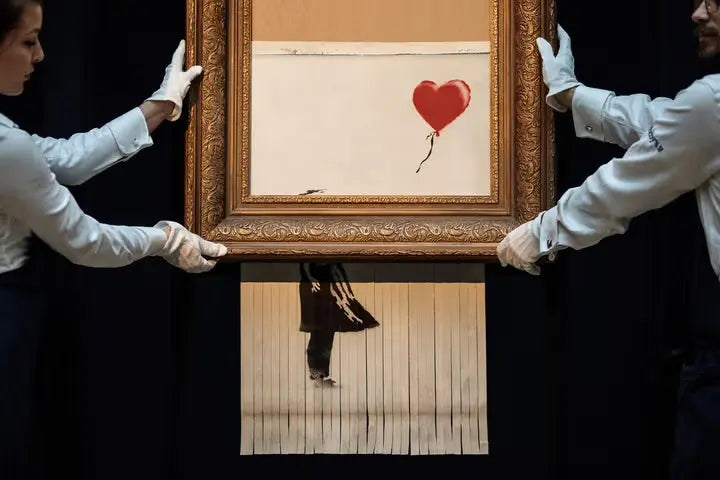In the urban odyssey of our time, where concrete becomes a canvas and the streets an open-air museum, stands the enigmatic figure of Banksy.
Like a modern-day Sisyphus, he tirelessly challenges the mountains of conventional art, pushing his rock of rebellion against the smooth slopes of the established order.
Banksy, in his anonymity, embodies the quest for truth and freedom, recalling Naval's words: "Play iterated games. All the returns in life, whether in wealth, relationships, or knowledge, come from compound interest." In each stencil, each stroke of the spray can, Banksy plays a repeated game, where the compound interest is not in money, but in cultural impact and social resonance.

The Enigma of Identity
Banksy's anonymity is central to his art. This lack of public identity creates a veil of mystery which reinforces the impact of his work. Who is he ? A man, a woman, a collective? This question remains unanswered, adding an additional dimension to his art.
This anonymity is not only a protection against the authorities, but also an artistic statement in itself, placing emphasis on the work rather than the person behind it.
Banksy's works are instantly recognizable. Using mainly stencils, he creates striking images, often accompanied by incisive texts. His favorite themes? Politics, pop culture, morals and ethics.
Each work is a critique, a satire or a reflection on our society. Banksy doesn't just paint; he communicates, he challenges.

Street Art as a Backdrop
Now let’s look at how Banksy uses urban space as his canvas. His works are not confined to art galleries; they are an integral part of the urban environment, interacting with it in meaningful ways.
Each of Banksy's works is closely linked to its location. A stencil on a crumbling wall, a drawing on a bridge, each choice of location is deliberate and adds a layer of meaning to the work.
These locations are not chosen at random; they are essential to understanding the message. Banksy's art is not just visual; it is contextual.
The urban environment amplifies Banksy's message. A drawing on the separation wall in Palestine, for example, is not just a work of art; it is a political statement. Streets, walls, bridges become communication supports, transforming public space into an open forum. Banksy doesn't just decorate the city; he questions her, challenges her.

Commercialization: An Intriguing Paradox
As an openly anti-capitalist artist, Banksy's growing popularity and the high market value of his works raise intriguing questions about the dynamics of the contemporary art market.
Although Banksy criticizes the capitalist system and its excesses, his works have become objects of desire in auction houses and art galleries. This situation creates a striking contrast: an artist who denounces the commercialization of art himself becomes a valuable brand on the market. How to interpret this phenomenon? Is this irony or a deliberate strategy? In our opinion, Banksy skillfully plays with this paradox, using commercialization as a way to spread his subversive messages to a wider audience.
The transformation of Banksy's rebellion into a marketable product is a phenomenon that deserves careful consideration. On the one hand, this might seem to dilute the authenticity and reach of its message. On the other hand, it allows his social critiques to penetrate spheres that might otherwise have remained inaccessible. Banksy, in navigating these complex waters, raises essential questions about art, value and resistance in a consumer society.

Impact and Reception: A Barometer of our Society
His creations, much more than simple artistic expressions, function as a barometer of our times, measuring the pressures, tensions and moods of our contemporary world.
Banksy's works, often provocative and loaded with social and political messages, reveal the cracks and contradictions in our society. They address themes such as mass surveillance, social inequalities, armed conflicts and humanitarian crises.
By placing these subjects at the heart of public space, Banksy does not just make them visible; it makes them unavoidable, forcing the passerby to question themselves, to react, even to take a position.
The reception of Banksy's works varies greatly, reflecting the diversity of perspectives and cultural contexts. Some are celebrated for their audacity and relevance, while others are criticized, even vandalized, perceived as intrusions or provocations. This evolving reception is testimony to Banksy's impact on the public. She shows how her art, by interacting with spectators, becomes a subject of debate, a catalyst for dialogue.
Banksy's art also has a significant impact on cultural discourse. His works inspire discussions about art, politics, ethics and society. They influence other artists, writers, filmmakers and thinkers, thus enriching the cultural landscape. Banksy is not just an artist; it is a cultural phenomenon, a point of reference in discussions about contemporary art and its role in society.



Share: